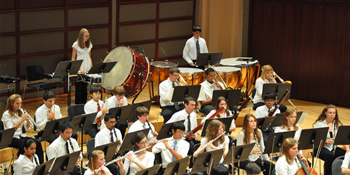This preview has been provided by the Philharmonic Association.
I cannot begin to describe how exciting it is to conduct this amazing group of young musicians. Despite their tender years, many of them are outstanding players already and, with every rehearsal, I am seeing tremendous growth, not only technically but also with increasing passion and expressiveness.
We are opening the Fall concert with the first movement from one of W.A. Mozart’s sunniest achievements, the Symphony in D, No. 31 also known as the “Paris” Symphony. Despite being written at one of the least happy periods of his life — Spring of 1778 while in Paris during a fruitless job search and concurrent with the death of his mother — the symphony is brimming with fresh melodic ideas and orchestral brilliance. The symphony is notable at the time for its unusually large instrumentation, scored for a large orchestra that was available to Mozart during his time in Paris: 2 flutes, 2 oboes, 2 clarinets in A, 2 bassoons, 2 horns, 2 trumpets, timpani, and strings. This symphony was Mozart’s first to use clarinets. The first movement opens with a rising and accelerating D major scale in an effect known at the time as the Mannheim Rocket. Listen for a surprise in the middle of this movement that prompted the jaded Parisian audience to burst into applause and demand a “da capo,” from the beginning.
We follow with a brief but electrifying piece from N. Rimsky-Korsakov (arranged by Merle J. Isaac), the famous “Procession of the Nobles,” from his opera Mlada. It is full of brass fanfares, woodwind flourishes and a rousing virtuosic timpani part. As a bit of trivia, this piece was long used as the theme for the PBS public affairs program Washington Week in Review.
Next come four selections drawn from the two posthumous Carmen Suites, Georges Bizet’s timeless and evocative music which continues to delight. The fiery “Toreador Song” which opens the actual opera, the gently soaring “Intermezzo” with some lovely solo work by the flute and clarinet, the spirited “Aragonaise” from Act IV and finally, the “Danse Boheme” from Act II, which starts simply enough with pizzicato low strings and a quirky woodwind melody then builds to a frenzy of tempo and dazzling orchestral effects, are all sure to get your blood racing and put a smile on your face. If you missed the recent NC Opera’s production of Carmen, now is your chance to hear these glorious melodies once again.
We close with one of the most popular works in the entire Symphonic repertoire, Antonin Dvořák’s Symphony From the New World, a work written in 1893 while Dvořák was director of the National Conservatory of Music in New York City. It was intended to be the culmination of his desire to incorporate both Native American and African-American influences as an impetus for American composers to find their own national style of music. Nevertheless, the music is firmly rooted in his native Bohemia and follows classical models, especially in the First Movement (which is, sadly, all we have time for). After the contemplative, almost mournful beginning, interrupted by a rousing horn call, woodwind shrieks and timpani outbursts, we are introduced to the syncopated figure that will be the primary melodic motif of the movement. The exposition and development are rife with melodic and orchestral invention and the conclusion is exhilarating in the extreme.
I hope you will join me in celebrating this glorious music and the dedicated young players who are giving their best every week to make it happen.











